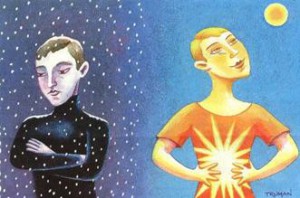Seasonal affective disorder, or SAD, is a condition that affects peoples’ moods. As the season moves into autumn, people with SAD experience depression, fatigue and listlessness when the days grow shorter and the temperature drops. This serious reaction to the changing seasons can have a profound effect on how a person functions. Most people suffer from winter and fall SAD while others suffer from spring and summer SAD. The symptoms and signs of SAD reoccur at the same time each year, but each person has a different reaction to the seasonal shifts.
Winter Depression Symptoms
During fall and winter SAD, a person feels depressed and hopeless. He may sleep a great deal but still feel very tired or fatigued. With winter depression a person may isolate himself from family and friends and take little interest in his normal routine, such as hobbies. Other symptoms include being anxious and having trouble concentrating. Some people overeat, adding large amounts of carbohydrates to their diet, which leads to weight gain. MedicineNet states, “It is believed that affected persons react adversely to the decreasing amounts of light and the colder temperatures as the fall and winter progress.”
Summer Depression Symptoms
The symptoms of SAD during spring and summer are almost the opposite of those of winter depression. According to MedicineNet, “there are those who suffer from this condition during the summer instead of, or in addition to, during the fall or winter.” While anxiety is a part of both types of SAD, with summer depression a person sleeps very little or has insomnia. A person is also irritable and easily agitated. With summer depression a person often has little interest in food and loses weight, but the sex drive increases.
Reverse SAD Symptoms
According to the Mayo Clinic, reverse SAD is rare. With this condition a person doesn’t have the depression of spring and summer SAD. Instead, a person has episodes of mania or hypomania. Mania is an elevated mood in which a person feels euphoric and energetic. During a manic phase a person may be hyperactive and reckless. Another sign is increased social interactions. Hypomania is a milder form of mania with less extreme behavior and feelings.
